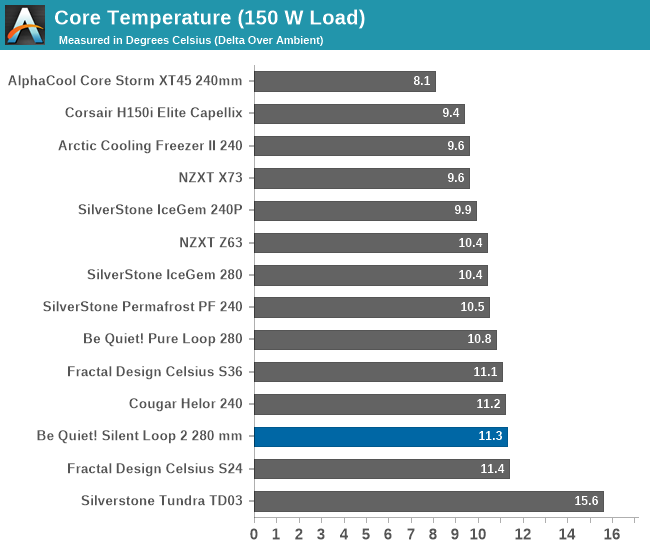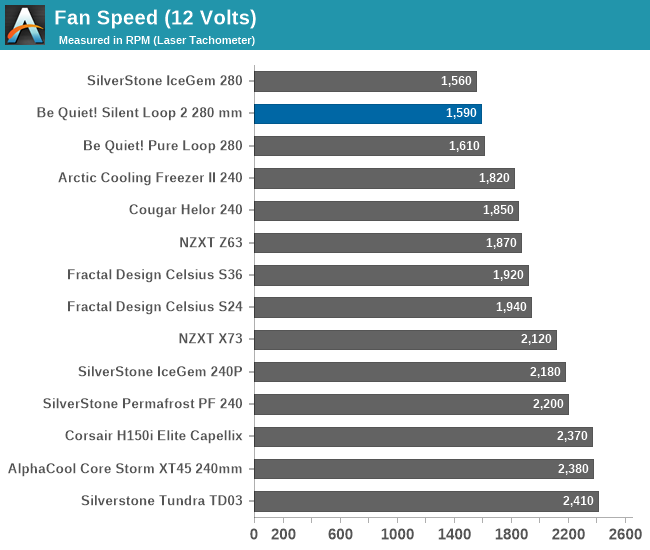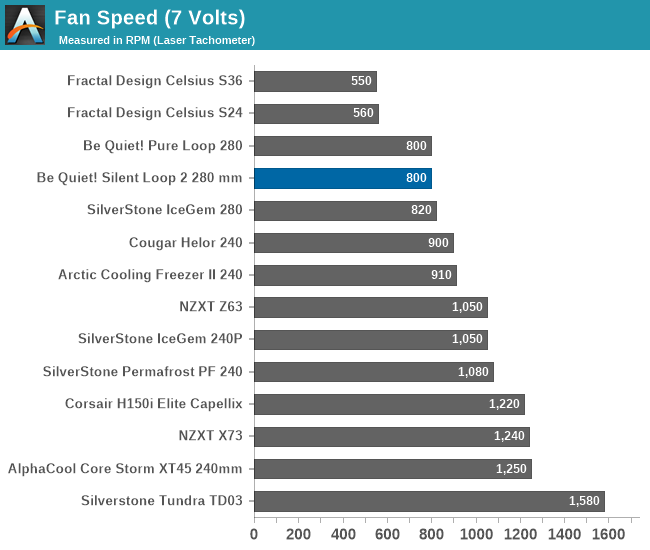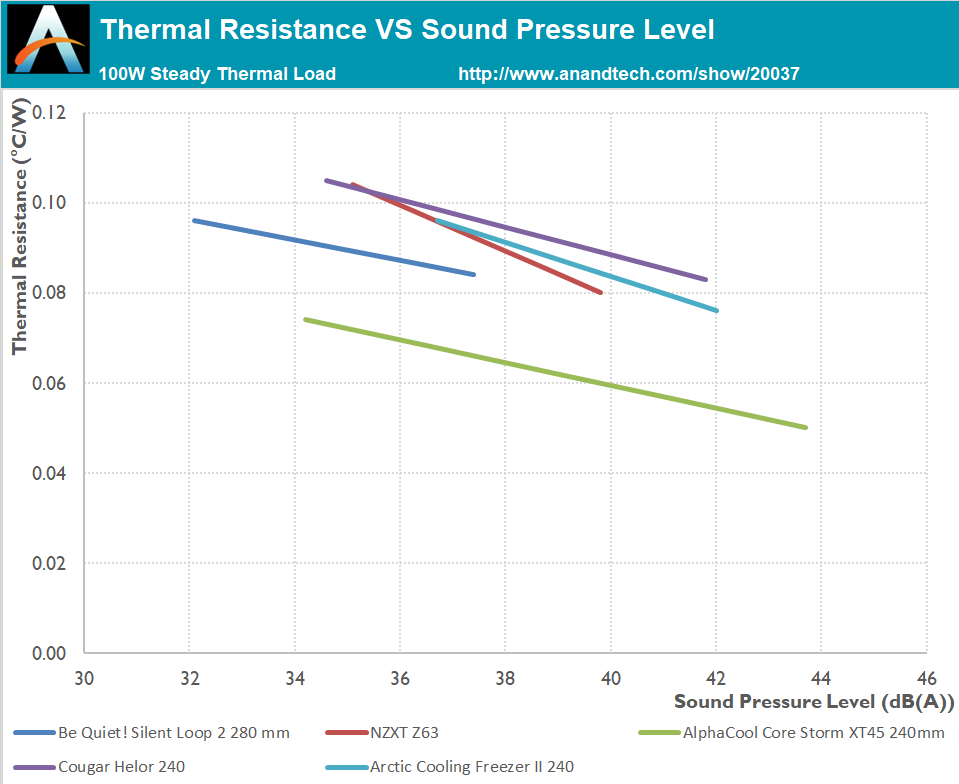The Be Quiet! Silent Loop 2 AIO Cooler Review: Quiet and Unassuming
by E. Fylladitakis on September 7, 2023 9:30 AM ESTTesting Results, Maximum Fan Speed
Our maximum speed testing is performed with both the fans and the pump of the kit powered via a 12V DC source. This input voltage should have the pump and fans matching the speed ratings of the manufacturer. The Silent Wings 3 fans rotate at just a little below their rated speed, with our tachometer reading 1590 RPM. We got the exact same speed readings from both fans, a hint of good manufacturing consistency.


| Core Temperature, Constant Thermal Load (Max Fan Speed) |
The thermal performance of the Silent Loop 2 280 mm cooler initially appears unimpressive in comparison to other AIO coolers of similar size. The average thermal resistance of 0.081 °C/W may be adequate for a modern CPU, but is a figure that many other similarly sized – and even smaller – products can achieve. That includes Be Quiet!’s older Pure Loop range of AIO coolers.

In complete contradiction to the thermal performance results, the acoustics performance of the Silent Loop 2 is exceptional. With both of its fans at maximum speed, our meter took a reading of just 37.4 dB(A). It is an audible figure but one that would be comfortable for typical daytime use. We could not discern any noise coming from the liquid pump at all.

Testing Results, Low Fan Speed
Using a PWM voltage regulator, we reduced the speed of the fans manually down to half their rated speed, which is 800 RPM for the Silent Wings 3 140 mm fans. The pump was also connected to the same power source, functioning properly at this low speed setting.


| Core Temperature, Constant Thermal Load (Low Fan Speed) |
Thermally, the results indicate that the Silent Loop 2 performs similarly to other comparable AIO cooler designs, yet is a step behind most. The average thermal permittance of 0.1026 °C/W is a good figure but hardly impressive for a 280 mm liquid cooler. At first sight, one can discern that even some designs with 240 mm radiators perform better – however, a closer look reveals that the fans of the Silent Loop 2 rotate at a very low speed during this test.

Much like our previous tests, the noise output of the Be Quiet! Silent Loop 2 under these operating conditions is extremely low, at just 32.1 dB(A). To regular human ears, this is entirely inaudible from a distance of one meter. There also is no noise coming from the main block assembly at all, with the pump managing to operate without even the slightest hydrodynamic noise coming from it. Although the Be Quiet! Silent Loop 2 does not sit all by itself at the top of the chart, 32.1 dB(A) is the lowest sound pressure level figure we have recorded from AIO coolers to this date.

Thermal Resistance VS Sound Pressure Level
During our thermal resistance vs. sound pressure level test, we maintain a steady 100W thermal load and assess the overall performance of the coolers by taking multiple temperatures and sound pressure level readings within the operating range of the stock cooling fans. The result is a graph that depicts the absolute thermal resistance of the cooler in comparison to the noise generated. For both the sound pressure level and absolute thermal resistance readings, lower figures are better.
This graph reveals the true strength of the Silent Loop 2 AIO cooler, which is no other than silent operation. The thermal resistance range of the cooler is small, suggesting that only a significant change in the speed of its fans would make a tangible performance difference. Regardless, the Silent Loop 2 achieves these thermal resistance figures at significantly lower dB(A) than other similarly sized AIO coolers. Only custom liquid cooling kits that are significantly more powerful (and expensive) have a notable performance edge over the Silent Loop 2.











22 Comments
View All Comments
mr2ns - Thursday, September 14, 2023 - link
I apologize; I'm not attempting to drag you in on the copy edit comments but just trying to point out that IF he was intending to reply to your analysis of the performance then he replied to the wrong posts. Then again, meaculpa has been around the Anandtech block more than a few times so that was probably unnecessary.back2future - Saturday, September 9, 2023 - link
1) mediocrity within a range of possible developments for cost or a price (not about technology for a 21. century level of 'heat dissipation')2) enthusiasts are developers who aim towards impossible setups without (necessarily) being backed with company infrastructures and doing with a limited budget (that's impressive, but getting harder with technology being more diverse and specialized development structures), getting towards lower noise than to be heard within a silent room running full spec or oc tasks could be a lower priority compared to limiting logics&sram&peripherals(&gpu) heat addition from its source (some of it will appear with photon switched transistors within circuits(?, 'fastest demonstrated all-optical switching signal is 900 attoseconds'), but 'enthusiasts' designing optical circuits(?), again a rare niche to meet and worth a price(?) )